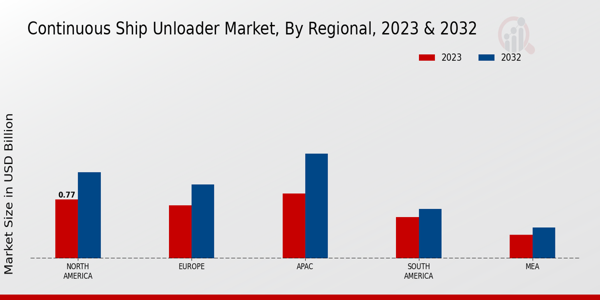Market Growth Projections
The Global Continuous Ship Unloader Market Industry is projected to experience robust growth, with estimates indicating a market size of 3.42 USD Billion in 2024 and a potential increase to 5.28 USD Billion by 2035. This growth trajectory reflects a compound annual growth rate (CAGR) of 4.03% from 2025 to 2035. The anticipated expansion is driven by various factors, including increasing demand for bulk commodities, technological advancements, and the expansion of port infrastructure. These projections highlight the industry's resilience and adaptability in meeting the evolving needs of global trade and logistics.
Expansion of Port Infrastructure
The expansion of port infrastructure globally is a significant driver for the Global Continuous Ship Unloader Market Industry. As trade volumes increase, many countries are investing in upgrading and expanding their port facilities to accommodate larger vessels and higher cargo throughput. For example, major ports in Europe and Asia are undergoing significant renovations, which include the installation of advanced unloading systems. This expansion is expected to create a favorable environment for continuous ship unloaders, as they offer the necessary efficiency and speed required for modern port operations. Consequently, this trend is likely to bolster market growth in the near future.
Increasing Demand for Bulk Commodities
The Global Continuous Ship Unloader Market Industry experiences a notable surge in demand for bulk commodities, driven by the growing global population and industrialization. As countries expand their manufacturing capabilities, the need for efficient unloading systems becomes paramount. For instance, the demand for iron ore and coal has risen significantly in regions like Asia-Pacific, where rapid urbanization is underway. This trend is expected to contribute to the market's growth, with projections indicating the market could reach 3.42 USD Billion in 2024. The efficiency of continuous ship unloaders in handling large volumes of materials positions them as a preferred choice for port operators.
Rising Investment in Renewable Energy Projects
The Global Continuous Ship Unloader Market Industry is witnessing a rise in investment in renewable energy projects, particularly in the context of offshore wind and solar energy developments. These projects often require substantial amounts of raw materials, such as steel and concrete, which necessitate efficient unloading systems. As countries commit to increasing their renewable energy capacities, the demand for continuous ship unloaders is expected to grow. This trend aligns with global efforts to transition towards sustainable energy sources, thereby enhancing the market's potential. The interplay between renewable energy investments and unloading technologies could significantly shape the industry's future.
Technological Advancements in Unloading Systems
Technological innovations play a crucial role in shaping the Global Continuous Ship Unloader Market Industry. Recent advancements in automation and control systems enhance the efficiency and reliability of unloading operations. For example, the integration of IoT technologies allows for real-time monitoring and predictive maintenance, reducing downtime and operational costs. These innovations are likely to attract investments, as companies seek to modernize their facilities. As a result, the market is anticipated to grow at a CAGR of 4.03% from 2025 to 2035, potentially reaching 5.28 USD Billion by 2035. This trend underscores the importance of adopting cutting-edge technologies in maintaining competitive advantage.
Environmental Regulations and Sustainability Initiatives
The Global Continuous Ship Unloader Market Industry is increasingly influenced by stringent environmental regulations and sustainability initiatives. Governments worldwide are implementing policies aimed at reducing emissions and promoting eco-friendly practices in port operations. Continuous ship unloaders, known for their efficiency and reduced environmental footprint, align well with these regulatory frameworks. For instance, the adoption of electric and hybrid systems in unloading operations is gaining traction, reflecting a shift towards greener technologies. This trend not only helps companies comply with regulations but also enhances their corporate social responsibility profiles, potentially driving market growth in the coming years.














